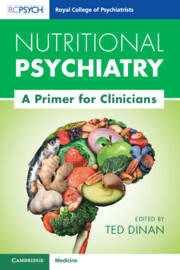Book contents
- Nutritional Psychiatry
- Nutritional Psychiatry
- Copyright page
- Contents
- Contributors
- Preface
- Chapter 1 Basic Principles of Nutrition
- Chapter 2 Diet and the Microbiome–Gut–Brain Axis
- Chapter 3 The Mediterranean Diet and Mental Health
- Chapter 4 Psychobiotics and Fermented Foods
- Chapter 5 Diet Interventions for Anxiety and Depression
- Chapter 6 Schizophrenia, Microbiota and Nutrition
- Chapter 7 Recognising the Importance of Nutrition for Child and Adolescent Mental Health
- Chapter 8 Old Age and Nutrition
- Chapter 9 Broad-Spectrum Micronutrients and Mental Health
- Chapter 10 Epigenetics
- Index
- References
Chapter 6 - Schizophrenia, Microbiota and Nutrition
Published online by Cambridge University Press: 17 August 2023
- Nutritional Psychiatry
- Nutritional Psychiatry
- Copyright page
- Contents
- Contributors
- Preface
- Chapter 1 Basic Principles of Nutrition
- Chapter 2 Diet and the Microbiome–Gut–Brain Axis
- Chapter 3 The Mediterranean Diet and Mental Health
- Chapter 4 Psychobiotics and Fermented Foods
- Chapter 5 Diet Interventions for Anxiety and Depression
- Chapter 6 Schizophrenia, Microbiota and Nutrition
- Chapter 7 Recognising the Importance of Nutrition for Child and Adolescent Mental Health
- Chapter 8 Old Age and Nutrition
- Chapter 9 Broad-Spectrum Micronutrients and Mental Health
- Chapter 10 Epigenetics
- Index
- References
Summary
Schizophrenia is a complex heterogeneous neurodevelopmental disorder involving the intricate interplay of genetic susceptibilities and the accumulation of prenatal and postnatal environmental stressors. At the interface between the individual and the environment, the diverse microbial ecosystem in the gut (microbiota) plays an important role in the regulation of homeostasis, particularly immune, metabolic and endocrine pathways. Pre-clinical studies show that the signalling pathways of the microbiome–gut–brain (MGB) axis influence brain development and function, including modulation of stress sensitivity, social interaction and cognitive function. Human studies in infants indicate associations between the gut microbiota and components of cognition and behaviour. Preliminary clinical studies demonstrate that schizophrenia is associated with altered gut microbiota signatures compared to healthy controls. Faecal microbiota transplantation studies from people with schizophrenia induce changes in brain neurochemistry and behaviour, which suggests a physiologically relevant role. Microbial-based interventions in schizophrenia are at an early stage of development, but a deeper understanding of the overlapping and complementary interaction between the MGB axis and diet and exercise and their relationship to other lifestyle factors could open avenues to modify susceptibility to, or exacerbation of, components of schizophrenia. This chapter will review the MGB axis and its interaction with diet, exercise, stress and antipsychotics in the hope that this will provide mental health professionals with an understanding of the MGB axis as an additional modifiable system that could be harnessed to improve health outcomes in schizophrenia.
- Type
- Chapter
- Information
- Nutritional PsychiatryA Primer for Clinicians, pp. 101 - 120Publisher: Cambridge University PressPrint publication year: 2023



